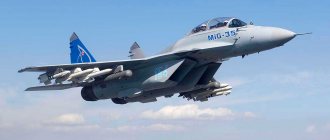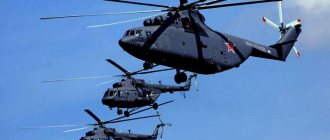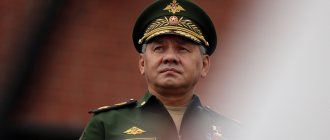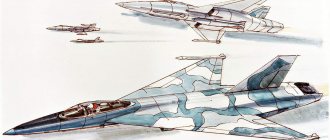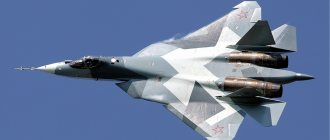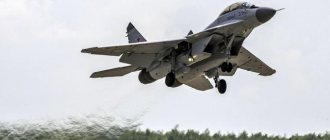Air battle T-50 versus Raptor: the mystery of the newest Russian fighter revealed
A short takeoff run and a pair of the latest T-50 fighters take off from the runway of the State Flight Test Center of the Ministry of Defense named after V.P. Chkalov in Akhtubinsk. It is here that fighters are, as they say, “put on the wing”: hours of flights, dozens of combat exercises performed - will become the basis of combat instructions for combat pilots, who next year will have to master the main novelty of the Russian aviation industry. For the first time, Alexander Egorov, the host of the ZVEZDA TV channel program “Military Acceptance”, was allowed to get acquainted with the secrets of the promising front-line aviation complex (PAK FA).
Chasing the Predator
The T-50 is the quintessence of everything modern that exists in domestic aviation. This is an aircraft designed to challenge the American 5th generation fighter F-22 Raptor (Predator). Proving, if not our superiority over our competitors, then at least our technological compliance with the best examples of modern military equipment. Our plane is “late” for its appearance by several years. The American is not only in service, but also recently participated in combat missions against Islamic State militants in Iraq. However, the aircraft designer Alexander Davidenko does not hesitate to say that the T-50 will be better than the F-22.
“The basic functions remain the same, but we tried to make them better,” says the designer. Emphasizing that when developing the PAK FA, Sukhoi Design Bureau simulated an air battle between the T-50 and the F-22.
It is not difficult to believe in the superiority of one aircraft over another if we recall the history of the creation of another favorite of the modern aircraft industry, the Su-27. The car was created as a counterweight to the American F-15 fighter. As in the case of the T-50, our car was “late.” The American flew and fought. Scored points. But in the end he ended up far behind the newcomer. After all, looking at the “favorite”, the Sukhoi Design Bureau tirelessly “polished” Sushka since 1977 until it became the absolute leader of world aviation. During some of them, the Indians “destroyed” the Americans in the F-15C/D Eagle.
After the completion of those exercises, American General Hal Homburg, who heads the Air Combat Command of the US Air Force, was forced to say that the results obtained were a complete surprise for American pilots: “We are not as ahead of the rest of the world as we would like to think. And now we have an even more advanced Su-35. “Behind the scenes”, until the T-50 was officially presented, this fighter was considered in the West as the Russian answer to the F-22. In fact, this is what it is - a “5th generation prototype” - the main systems of the T-50 are already being tested and mastered by combat pilots on this particular machine.
It is precisely because of this ongoing evolution that no one, not even the designers, knows what the final production version of the PAK FA will be like. The same Su-35 can be used to judge how long this process can take. “The military is constantly changing the technical specifications, trying to get the “ideal” aircraft for the “unclear” conditions of use,” says our source in the aviation industry.
Apple from the apple tree
However, the quiet evolution of the T-50 is already quite visible. As Alexander Davidenko told the ZVEZDA TV channel, the share of composite materials in the total mass of an empty aircraft is 25%, and on the surface of the aircraft - 70%. The widespread use of composites in the design of the aircraft has made it possible to reduce its weight, as well as significantly facilitate the preparation of mass production.
Alexander Egorov was personally convinced that the T-50 is “plastic”. During the filming of the “Military Acceptance” program, the ZVEZDA TV channel was shown for the first time how parts of a promising fighter are created from “threads” and “glue”, which will ultimately be two times lighter than aluminum of comparable strength and four to five times lighter than steel. Twice lighter than titanium. As a result, the weight of the fighter becomes four times less compared to an aircraft assembled from conventional materials, and its radio signature tends to zero.
“Thanks to the use of composite materials, the number of parts has been significantly reduced: compared to the Su-27 aircraft, the number of parts has decreased by four times,” said the designer. “This also made it possible to significantly reduce the radar signature of the aircraft.”
The Sukhoi Design Bureau talks about its “unprecedentedly low level”: the radar, optical and infrared “visibility” of the vehicle. The effective reflective surface area of the T-50 today is 0.5 square meters. m (for the Su-30MK - 20 sq. m). To understand: this means that on the radar the Su-30MK is visible as a metal object measuring 5 by 4 m, and the reflection of the T-50 is 40 times smaller. This matches the F-22's readings.
The only problem that gives reason to doubt that the PAK FA belongs to the fifth generation is its engines. The prototypes fly on AL-41F1 engines, also known as Ideliye 117S. They are also used today on the Su-35S. It is these engines that are planned to be installed on the first production T-50. As Sukhoi Design Bureau test pilot Sergei Bogdan said, on its first flight the new Su-35 accompanied the Su-30MK. This made it possible to compare the thrust characteristics of the engines of the two aircraft.
During the flight, the Su-35 accelerated in non-afterburning mode, while the pilot of the escort aircraft had to use afterburner, periodically lagging behind the new vehicle. According to the pilot, this is a very serious advantage, giving the combat pilot more opportunities when conducting air combat. However, although the 117C provides the necessary total thrust, sufficient even to achieve supersonic cruising speed, it does not meet the requirements of the fifth generation in terms of weight-to-thrust ratio, as well as fuel consumption.
Full fifth generation engines, known today as "Type 30" or "stage two" engines, are in the design stage. The project includes several development stages: low pressure compressor, gas generator, high pressure compressors, combustion chambers, high and low pressure turbines, afterburner and nozzles. Last year it was planned to complete their design and release technical documentation for the technology demonstrator. Development work on the project is expected to be completed in 2016. The technical complexity of the project will require very lengthy bench and flight tests, which will affect the overall development time of the T-50. According to various estimates, Russian T-50 fighters will receive power plants of the second stage only in 2025-2027.
Technologies of Excellence
The general director of the Federal Research and Production Institute, part of the United Instrument-Making Corporation, Alexei Komyakov told the TV channel that most of the aircraft’s electronic systems are just being handed over to the customer - the Ministry of Defense. A few months ago, his company supplied the latest S-111 communications complex and an integrated antenna-feeder system for the T-50.
“The S-111 is fundamentally different from all previous developments,” says the designer, “it provides the aircraft with a new level of efficiency in obtaining information at all stages of flight and in all types of combat operations. To implement these characteristics, packet data exchange in digital form, broadband radio communication channels, and new methods of combating interference are used to increase the range and quality of communication.” Now all subsystems in aircraft equipment have their own antennas,” explains Komyakov. The number of antennas on one aircraft can reach several dozen. This significantly increases radio visibility, increases the cost and complexity of the object. The new generation antenna-feeder system allows you to combine antennas for transceiver equipment for various purposes of communication, navigation, identification, etc. Minimize the number of antenna devices. They are built into the fuselage skin, which is protected by a radio-transparent coating, which reduces aerodynamic drag and reduces radar signature.
The T-50 implements another main requirement for modern fighters - high intelligence on board. A fighter radar with a new active phased antenna array (AFAR) from the Tikhomirov Research Institute is more than a thousand miniature transmitting and receiving devices combined into a single field with high output signal power. An AFAR radar sees everything that is happening in the air and on the ground at a distance of several hundred kilometers. Can lead multiple targets while simultaneously aiming the fighter's weapons at them. And, as the designers say, fire at them all at the same time, literally firing rockets out of the plane like a fan. Moreover, both against air and ground targets.
In addition, the edges of the PAK FA wings are literally pierced with antennas. Because of this, the fighter is able to see what is happening above, below and around him literally 360 degrees. Several dozen different sensors are located throughout the fuselage of the vehicle, which will allow not only to monitor the situation around the vehicle, but also to exchange data in real time, both with ground control systems and within the aviation group. That is, by integrating the fighter into the global system of combat operations, the counter can simultaneously involve both escort aircraft: A-50 long-range radar reconnaissance aircraft, attack aircraft, bombers, helicopters, and air defense systems on the ground, as well as motorized rifle units. In fact, the T-50 can be both an independent attack weapon and a spotter for a global military operation.
Electronic pilot
The T-50 cockpit, unlike the Su-27, does not have analog instruments with the usual needles. Instead, there are two large color LCD screens. They, like a regular TV, display all the information the pilot needs in picture-in-picture mode. Hydrodynamic control drives of the power plant have been replaced by electric ones. According to the designers, this not only saves space and weight, but also allows parallel (remote) control to be introduced into the machine control. In practice, this means that the pilot's role becomes less prominent. That is, the computer decides at what speed and in what modes the vehicle will approach the target and at what moment to allow the pilot to use the weapon.
At the same time, the machine takes on some of the complex flight modes - for example, flying at extremely low altitudes while skirting the terrain. Just as he will ensure that the pilot uses weapons safely for the fighter or does not throw the plane into an uncontrollable tailspin.
For the first time, the T-50 has a domestic inertia-free navigation system - SINS. This is an electronic-mechanical device, without which not a single fighter today can be considered modern. Its task is to collect and analyze all flight information and ensure the departure and return of the aircraft to its airfield. SINS works in conjunction with GPS and GLONASS receivers, but can also work without them.
Long Arm of the Air Force
The T-50 can take off and land using sections of the runway 300-400 meters long. In the future, a naval version of the fighter should be created on its basis. The developers say that the plane will reach speeds of more than two thousand kilometers per hour and fly over distances of up to five thousand kilometers.
“From the same Akhtubinsk, this plane could easily fly somewhere to the shore of the Atlantic or Indian Ocean and return. For this machine, the concepts of distance are completely different,” Alexander Egorov stated with surprise when he learned that the chief pilot of the Sukhoi Design Bureau, Sergei Bogdan, needed only one refueling to fly from Komsomolsk-on-Amur to Zhukovsky near Moscow.”
The armament of the new vehicle will be completely stored in the internal compartments of the fighter, although there are also external hangers. Almost nothing is known about the T-50's weapons. But drawing parallels with the Su-35, we can assume that the PAK FA will initially use a whole range of medium-range air-to-air missiles.
For example, R-27ER1 (8 pcs.), R-27ET1 and R-27EP1 (4 pcs each), RVV-AE (up to 12 pcs., including a twin suspension of four missiles under the fuselage) and R-73E close-in missiles ( 6 pcs.), includes 5 new long-range missiles. The range of air-to-surface guided weapons: 6 tactical missiles Kh-29TE or Kh-29L, six anti-ship and anti-radar missiles Kh-31A and Kh-31P, five new long-range anti-ship missiles Kh-59MK, as well as new items: 5 anti-radar extended-range missiles of the Kh-58USHE type, three long-range missiles of the Caliber-A system and one heavy long-range anti-ship missile of the Oniks type.
The fighter will be able to lift up to eight KAB-500Kr adjustable bombs with television homing, the latest KAB-500S-E with a satellite guidance system, as well as up to three 1500 kg caliber bombs - KAB-1500Kr or KAB-1500L G with television or laser guidance. In terms of the range of bomber and unguided missile weapons, the Su-35 is generally no different from today’s Su-30MK, but in the future it will be able to use improved and new models of 500 and 250 kg caliber bombs and 80, 122 and 266/420 mm caliber missiles, in incl. with laser correction. The maximum combat load weight of the Su-35 is 8000 kg.
From unofficial sources, it is known about the T-50 that special high-precision long-range missiles have been developed for it (AFAR operates at 400 km) with a square cross-section. This form, as a source in the aviation industry told the channel, makes it possible to place a larger number of them in the internal compartments of the fighter. Moreover, which is very important, these missiles can be targeted even before leaving the bomb bay. Previously, such technology simply did not exist.
Price issue
The T-50, like its competitor F-22, is insanely expensive. The cost of the Raptor creation program is estimated at $74 billion. The cost of one aircraft is $146 million. This is why the United States bought not several hundred of these machines, but only 187 aircraft. Our program is much cheaper, but Deputy Minister of Defense for Armaments Yuri Borisov said on March 23 that the military can purchase fewer fifth-generation T-50 fighters (PAK FA) than planned in the state armament program until 2022. The military will contract only 12 fighters and, after putting them into operation, will decide how many aircraft of this type they can afford, although previously they firmly expected to purchase 52 aircraft.
Borisov announced a possible reduction in purchases during a visit to the Komsomolsk-on-Amur aviation plant. He stated that “the enterprise is ready to begin serial production of the fifth-generation fighter since 2016. However, the Ministry of Defense reserves the right to revise the number of purchased vehicles. In new economic conditions, initial plans may be adjusted. It’s better for us to have a backlog in the form of the PAK FA and the opportunity, then move forward, fully squeezing all the capabilities out of the 4+ generation fighters of the Su-30 and Su-35 fighters,” the deputy minister emphasized.
https://youtu.be/WeH1okNwDMs
Author: Dmitry Litovkin Photo: Marina Lystseva, Konstantin Semenov
Source
In direct air combat, the F-22 Raptor has no chance against the T-50 PAK FA
Said Aminov, a military expert and editor-in-chief of the website “Vestnik PVO”, compared the capabilities of two fifth-generation fighters, the Russian T-50 PAK FA and the American F-22 Raptor.
The American fighter became the world's first serial fifth-generation fighter aircraft. The Russian PAK FA T-50 has yet to undergo state tests. The first aviation units equipped with it will appear in Russia by 2022. However, already now, according to the expert, it is possible to say by what parameters the Russian aircraft will surpass its predecessor.
“The American F-22 was created following the ideology of long-range missile combat. Due to its low visibility and long-range radar, in combination with medium-range missiles, it ensured the interception of air targets at acceptable distances, and without requiring involvement in an air battle,” the expert explained.
However, according to Aminov, the Russian fighter has a different philosophy - it combines the use of Stealth technologies with high maneuverability.
“The super-maneuverability capabilities of the Russian fighter provide it with significant benefits and advantages. We will be able to perform certain maneuvers, certain elements of air combat faster,” the expert noted. In his opinion, the PAK FA is superior to the F-22 in size, which allows it to accommodate more fuel. And what’s important is that the Russian fighter has one and a half times the American fighter’s flight range.
According to Aminov, the Raptor does not have external weapons mounts (the latest anti-radar missiles cannot be placed on board), while the weapons for the T-50 are designed in such a way that the latest weapons will be placed in the internal compartments of the aircraft.
It is also expected that the new engine for the T-50 will make the aircraft even more maneuverable and stealthy (the emissivity in the infrared range will decrease). Modern weapons will not leave the F-22 a chance in an air battle against the T-50.
“We are capable of not only detecting targets at maximum range, but tracking them and opening fire, even before the F-22 with its missile can strike back. Our missile allows strikes at ranges of over 150 km, and according to other sources, even more, while the Americans have a launch range of 120 km,” the expert assures.
He also recalled that one of the F-22 aircraft crashed during landing - the fact is that the aircraft’s control system had an incorrect code, which led to self-oscillation of the rudders, and the fighter went into self-oscillation while landing. According to the expert, in the United States they recklessly rely on electronics and machine solutions to complex problems that are sometimes inaccessible to a computer. In Russia, even in a fifth-generation fighter equipped with the latest electronic technology, the main decisions are made by the pilot.
Modern weapons will not leave the F-22 a chance in direct air combat against the T-50, concluded


